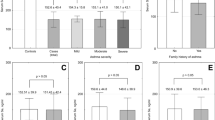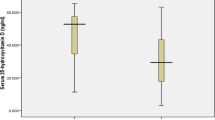Abstract
Thirty-four infants with acute bronchiolitis and 25 age-matched healthy controls were enrolled to investigate the possible relationship between serum malondialdehyde (MDA) and selenium (Se) levels and the occurrence and severity of acute bronchiolitis in children. Serum samples were taken for serum Se and MDA measurements, and the clinical score was assessed at admission. Blood was taken again from the children with bronchiolitis at 2 mo after discharge from the hospital. Mean serum MDA levels were significantly higher in patients with acute bronchiolitis than at the postbronchiolitis stage and the controls (4.2±2.5nmol./L, 1.4±0.8 nmol/L, and 0.7±0.2 nmol/L, respectively [p<0.001]). Infants with bronchiolitis had lower mean serum Se levels at the acute stage than after 2 mo (31.7±28.9μg/L versus 68.4±26.4 μg/L, p<0.05, respectively); both of which were significantly lower than the control group measurements (145.0±21.9 μg/L) (p<0.001). There was a negative correlation between serum MDA and Se levels in the patient group (=−0.85, p<0.001). The age of the patient, child's immunization status, parental smoking habit, and family crowding index were not correlated with serum Se, MDA levels, or clinical score at admission.
In conclusion, increased MDA levels and impaired Se status demonstrate the presence of possible relationship of these parameters with pathogenesis of acute bronchiolitis, and antioxidant supplementation with Se might be thought to supply a beneficial effect against bronchiolitis.
Similar content being viewed by others
References
M. A. Beck, H. K. Nelson, Q. Shi, et al., Selenium deficiency increases the pathology of an influenza virus infection. FASEB J. 15, 1481–1483 (2001).
M. P. Raymon, F. R. Abou-Shakra, N. I. Ward, et al., Comparison of selenium levels in preeclamptic and normal pregnancies. Biol. Trace Element Res. 55, 9–20 (1996).
J. V. Dobson, S. M.Stephens-Groff, S. R. McMahon, et al., The use of albuterol in hospitalized infants with bronchiolitis. Pediatrics 101, 361–368 (1998).
S. Schuh, G. Canny, J. J. Reisman, et al., Nebulized albuterol in acute bronchiolitis. J. Pediatr. 117, 633–637 (1990).
T. Asakawa and S. Matsushita, Coloring conditions of thiobarbutiric acid test for detecting lipid hydroperoxides, Lipids 15, 137 (1980).
K. M. Brown and J. R. Arthur, Selenium, selenoproteins and human health: a review, Public Health Nutr. 5, 593–599 (2001).
L. S. Harbige, Nutrition and immunity with emphasis on infection and autoimmune disease. Nutr. Health 10, 285–312 (1996).
M. K. Baum, M. J. Miguez-Burbano, A. Campa, et al., Selenium and interleukins in persons infected with human immunodeficiency virus type 1. J. Infect. Dis. 182 (Suppl.), S69-S73 (2000).
C. Lehmann, K. Egerer, M. Weber, et al., Effect of selenium administration on various laboratory parameters of patients at risk for sepsis syndrome. Med. Klin. 92(Suppl.), 14–16 (1997).
M. A. Beck, Antioxidants and viral infections: host immune response and viral pathogenicity. J. Am. Coll. Nutr. 20(Suppl.), 384S-388S (2001).
M. A. Beck, O. A. Levander, and J. Handy, Selenium deficiency and viral infection, J. Nutr. 133(Suppl.), S1463-S1467 (2003).
M. P. Raymon, The argument for increasing selenium intake. Proc. Nutr. Soc. 61, 203–215 (2002).
M. V. Nagibina, E. A. Neifakh, V. F. Krylov, et al., The treatment of pneumonias in influenza using antioxidants. Ter Arkh. 68, 33–35 (1996).
K. Sammalkorpi, V. Valtonen, G. Alfthan, et al., Serum selenium in acute infections, Infection 16, 222–224 (1988).
R. T. Sepulveda, J. Zhang, and R. R. Watson, Selenium supplementation decreases coxsackievirus heart disease during murine AIDS. Cardiovasc. Toxicol. 2, 52–61 (2002).
S. Hu, X. Liu, S. A. Yin, et al., Effect of selenium on children suffered from Mycoplasma pneumonia. Wei Sheng Yan Jiu 27, 344–347 (1998).
X. Liu, S. Yin, and G. Li, Effects of selenium supplement on acute lower respiratory tract infection caused by respiratory syncytial virus. Zhonghua Yu Fang Yi Xue Za Zhi 31, 358–361 (1997).
Author information
Authors and Affiliations
Rights and permissions
About this article
Cite this article
Gurkan, F., Atamer, Y., Ece, A. et al. Relationship among serum selenium levels, lipid peroxidation, and acute bronchiolitis in infancy. Biol Trace Elem Res 100, 97–104 (2004). https://doi.org/10.1385/BTER:100:2:097
Received:
Revised:
Accepted:
Issue Date:
DOI: https://doi.org/10.1385/BTER:100:2:097




